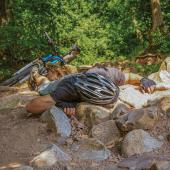Preventing Ankle Injuries
You might spend days, even weeks, gearing up for the hunting you’ve dreamed of tackling this summer—yet it takes only a split-second to be tripped up by a weak or unprepared ankle. So while you’re checking off your list of needed gear and other accoutrements, put one more item on your list: your ankles.
Are they, like your gear, in tip-top shape? Can they bear the load of your bodyweight plus pack on the shifting landscape and changing terrain below? Heck, simply jogging from your car puts about eight times your bodyweight through your ankle and foot with each step. Obviously, your ankles deserve some pre-hunt attention.
ANKLE JOINT
The ankle is formed by three bones. The main ankle bone is called the talus. It fits snugly in a socket formed at the lower end of the leg bones, the tibia (shinbone) and the fibula (the smaller bone that runs from the outside of the knee to the ankle). The bottom surface of the talus sits atop the calcaneus (heel bone). The ankle bones are held together by ligaments, tough bands of tissue that keep the joint from angling in the wrong direction. The inside (medial) edge of the ankle is supported by a thick, strong ligament, called the deltoid ligament. The outer (lateral) side of the ankle is supported by three main ligaments. These ligaments connect the outer bump of the ankle (the bottom end of the fibula bone) to the talus and to the calcaneus. These ligaments are aligned to keep the ankle from twisting or tilting too far.
Sprains
An ankle injury that commonly hampers hunters and hikers is a sprain to one or more of the lateral ankle ligaments. A sprain describes a ligament that has been stretched or torn. Most often, the ankle is sprained when it turns inward into inversion, meaning that the bottom of the foot angles toward the other foot. This forces your body weight onto the outer edge of the ankle, placing a strain on the lateral ankle ligaments.
The opposite of this type of sprain is an eversion sprain, which puts force on the deltoid ligament. Eversion sprains don’t happen that often, as the deltoid ligament can take a lot more force than the lateral ankle ligaments.
A more severe form of ankle sprain is called an ankle syndesmosis. This type of injury occurs from a forceful twisting of the ankle, which involves damage of several supportive ligaments of the ankle. It is sometimes called a “high ankle sprain,” as it involves ligaments in, around, and above the ankle. This type of injury takes at least twice the healing time as is needed after a simple inversion ankle sprain.
ANKLE FITNESS
Getting and keeping your ankles conditioned as you take on your favorite hike requires attention to a few key elements. (See the sidebar for sample exercises to improve ankle fitness.)
Joint Sense
It makes sense to get your ankles conditioned for the demands of your trip. “Joint sense” is the ability of your nervous system to know the position of your joints—that’s why this “sixth sense” is also called position sense. Sensors in and around the ankle joint can heighten the overall stability of your ankles when they're exercised and trained.
Flexibility
Tight muscles hinder performance and can set you up for an unwanted injury. For example, a tight calf muscle on the back of your lower leg can lead to a serious injury of the calf muscle or of the Achilles tendon. Therefore, it’s important to maintain flexibility in these and other key areas, particularly the trunk muscles and hamstrings.
Strength
Ankle injuries often happen when the muscles surrounding and supporting the ankle are weak or poorly conditioned. A muscle imbalance occurs when the muscles on the front of the shin are weaker than the calf muscles on the back of the shin. This imbalance, especially when combined with overuse, begins to tug on the muscles where they attach to the bone on the front of the lower leg, weakening the ankle and making it more susceptible to injury.
Agility
When your legs and ankles are flexible and strong and balance is not an issue, you may wish to advance your program to include agility drills. If you haven’t done exercises like these in a while, be cautious about doing too many, too quickly. Start with a small number of each exercise; say 10-20 of each. Build up by adding more repetitions and gradually attempt to leap higher and further.
FOOTWEAR
If you’ve had problems with weak ankles that turn in, you may want to consider changes within your footwear.
Insoles
A heel wedge under the outer half of your heel blocks the ankle from rolling in. A flared heel built into your boot does the same thing. For more severe cases of ankle weakness and instability, your healthcare provider may prescribe a supportive insole to be worn in your boot, called an orthotic. This device keeps your ankle from rocking too far from one side to the other.
Hunting Boots
Pick a durable boot, preferably one with full-grain leather with few seams. Leather boots are a good choice for their durability, along with the fact you can easily waterproof them. Generally speaking, the longer and more demanding the hunt, the bigger and more rigid the boot. Be sure the boot has a solid traction sole, ensuring added safety while walking on wet and slick surfaces. The sole should be thick and sturdy to protect your foot and ankle on rocky terrain. However, it should also be flexible in the front half of the boot so your forefoot can bend while propelling you forward.
Brent Dodge, PT is am orthopedic clinical specialist in physical therapy. He owns Alpine Physical Therapy in Missoula.










